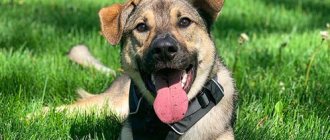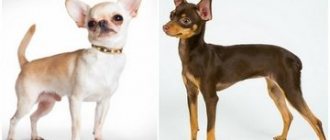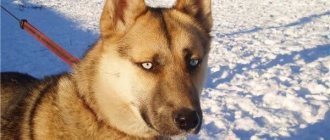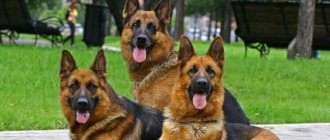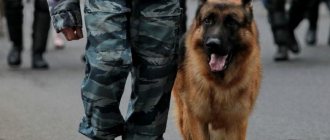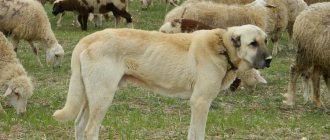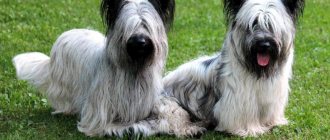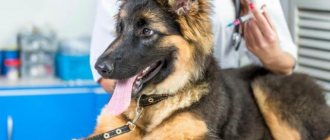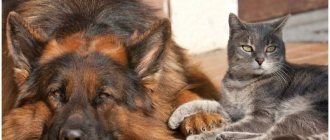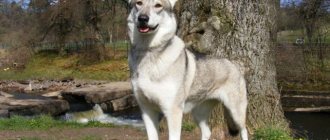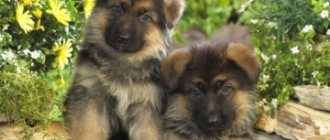The German Shepherd itself originated from crossing working dogs with herding dogs through many years of selection. Its recognition occurred at the end of the 19th century. The first exhibition in which the breed participated took place in 1899. Initially, the breed was intended to protect numerous herds of livestock. But with the reduction in the number of domestic animals, they began to look for other areas of application. The shepherd dog showed itself well as a search dog in the police and army. She is successfully used in guard and security services; she is an excellent protector and companion. This is the most popular dog breed all over the world.
In addition to the purebred breed, many of its mestizos have appeared, which differ from each other in appearance, habits, character, size, type and color of coat. For example, a crossbreed between a Doberman and a Shepherd, these 2 large breeds with a muscular body, an exterior similar to a Doberman, and took the color from a German.
The most popular and recognizable dog breed
German Shepherd Husky Mix
A cross between a husky and a German shepherd is known among dog handlers as the Shepski (or Siberian Shepherd). Dogs have an attractive appearance and have inherited the best character traits from their parents.
The mestizo has a large body. In the exterior, the features of a shepherd dog prevail. The husky inherited a “fur coat” - dense, thick wool. It provides protection for the animal in the cold season, but can cause overheating in the summer.
An interesting feature inherent in the Shepsky is its eyes of different colors: one is blue and the other is brown.
The character of the animal is distinguished by sociability, friendliness and devotion. Mestizos are suitable for both guarding and hunting. They are hardy, energetic, with a sensitive sense of smell.
Shilon
This German Shepherd mix originated in the 1970s. Dog trainer Tina Barber was disappointed with the health problems of the standard shepherd. They were too expensive for most families and also began to develop serious health problems such as hip dysplasia and curvature of the spine.
Barber wanted an affectionate but courageous companion with fewer health problems. She started with a German Shepherd. She crossed her with a Malamute, then with a Canadian White Shepherd. And finally, with the Czech wolfhound.
The Shiloh is the result of all these incredible breeds.
From mild to hard temperaments, this breed must be matched by potential owners who are evaluated by breeders to determine which temperament best suits their lifestyle.
German Shepherd-Wolf Mix
Getting a cross between a dog and a wolf is not easy. To do this, it is necessary to conduct a mating between a tamed she-wolf and a “German”. As a result, cubs are born that inherit the appearance and color of the mother: a lean, muscular body, gray (less often black) coat.
The wolf dog copes well with the functions of a guard. His character is dominated by determination, courage and good ability to learn commands. The dog does not show aggression towards people, but keeps its distance from strangers. Infinitely devoted to his master.
By inheritance from his wild ancestors, he inherited good health and the ability to navigate the natural environment with lightning speed.
Mixed breeds between wolves and dogs are rare. If you raise a puppy at home from childhood, then it will grow into an intelligent, loyal dog.
What you need to know before the inspection
Before choosing a puppy, it is recommended to find out a number of important questions that will help you avoid making the wrong decision. You should find out how many times a year a bitch gives birth - you should not take babies from one that does this more often than once a year. Practice shows that if childbirth occurs more than once a year, the mother does not have time to gain strength to bear a full-fledged offspring.
There should be no more than ten puppies in the litter - otherwise the mother does not have enough milk and internal resources to bear them well. Also take a look at what the babies look like - they should be approximately the same size, naturally taking into account the fact that a female shepherd puppy is always smaller than a male.
A cross between a German Shepherd and a mongrel
Sheepdog is a cross between a German Shepherd and a mongrel dog. The exterior of the mestizos has a vague resemblance to the “Germans”, more like an ordinary mongrel.
The dog is genetically resistant to diseases and adapts to outdoor living conditions. The animals are unpretentious and do not require special care.
Puppies are trainable and quickly learn commands. They have a strong sense of attachment to their owner.
Pros and cons of the nature of such dogs
A mixed-breed dog has its positive and negative qualities.
Mixed labrador and shepherd dog, mongrel, husky and other breeds
The advantages are:
- low price;
- excellent health.
As for the problems with mestizos, then:
- you cannot know exactly the dimensions of an adult pet (you can more or less guess by the size of its paws);
- As a result, you can get an individual with an unpredictable character.
Important! Any dog, regardless of breed, needs to be trained from an early age. Mestizos are no exception. A serious approach to learning can neutralize even pronounced negative qualities.
Other mestizos of the “Germans”
Nowadays, mixing dogs of different breeds is no longer a rarity. Mestizos often have an exotic, memorable appearance and inherit the distinctive character traits of their parents. You can find out about the most common crosses of “Germans” with other breeds from the table.
| Breed | Description |
| Laika | Friendliness, playfulness, strong attachment to the owner. Suitable for hunting and protection |
| Labrador | Restlessness, energy, goodwill, tolerance. Gets along great with children. Gets along well with other pets, incl. cats. Affectionate, obedient, easy to train. The perfect combination of guard and companion traits |
| Rottweiler | Calmness, self-confidence, curiosity, activity. Dominance over other animals. Successful training requires a strong-willed, strong person. Performs well the duties of a guard and defender. Large individuals weighing up to 50 kg |
| Golden retriever | Obedient, quick to learn, energetic. Suitable for security, hunting and search and rescue work. Excellent family companion dog |
| Chow chow | Smart, quick-witted, curious, obedient. Suitable for guarding, hunting, defense |
| Pug | Loving, playful. Companion. Medium sized animal |
| Welsh Corgi | Movable, restless, stubborn. Dominance is strongly expressed. Small sizes |
| Collie (Scottish Sheepdog) | Energetic, friendly, mischievous. Easy to train. Loves long walks. Used as a herding dog and also as a family companion |
| Akita Inu | Dynamic, stubborn, tolerant. Has a high level of socialization. Needs sufficient physical activity. Family Companion |
German Shepherds are also often crossed with Caucasian or Belgian (Malinois). The cubs are used for protection.
Any cross is a surprise, because... it is impossible to predict in advance whose genes will dominate. Therefore, you should approach the choice of a mixed-breed pet with special attention and caution.
Which German Shepherd mix is your favorite?
Characteristic differences in growing puppies
If you still decide to buy an “unconfirmed” puppy, then pay close attention to its appearance so as not to repent later. A dog is purchased for more than one year! If you want to get a faithful friend, whose meaning of life is contained in the motto: “Serve and protect!”, then you need to remember the main signs by which you can distinguish a shepherd from a mongrel.
Do not purchase a puppy before he is 3-4 weeks old!
Until this age, it is difficult even for a specialist to distinguish a HO (German Shepherd) from a large mongrel. By the age of one month, the baby develops characteristics characteristic of a purebred shepherd dog - generic differences.
Eyes
The BUT puppy's eyes are set slightly askew, have an almond-shaped cut , and when the baby turns his head, trying to look at a new object for him, the pure white white of the eyeball . Because of this eye structure, the shepherd's gaze is often compared to a human's. Such eyes are found in the “German” and in the East European Shepherd puppy.
The rainbow arch is from dark yellow to deep brown. Up to 2 months it can be blue or light blue. The look is lively, expressive, curious and playful.
Mongrel puppies have round, slightly protruding eyes. When turning the head, the protein stands out weakly, the color is yellowish or with dark spots. The gaze may be lively and curious, but it cannot be compared with a human one.
Ears
Clearly standing ears at 1.5-2 months old in a puppy is what distinguishes a mongrel from a shepherd dog 100%! A German Shepherd's ears don't stand up at this age! Large and soft ears of shepherd dogs appear by 6-8 months.
Moreover, often the ears first stand up like a house, then they fall, then they stand up one by one, and so on until they are completely fixed on the top of the head.
From the age of 3 months, puppies begin to change their baby teeth to permanent ones. At this time, babies’ ears are always “in decline.”
Teeth
A shepherd dog with good breed characteristics should have exactly 28 milk teeth by the beginning of the shift. No more is needed, less is also necessary. Fusing of teeth or malocclusion is unacceptable.
These dogs have a scissor bite. That is, the incisors of the upper jaw are directly above the incisors of the lower jaw, and the upper canines barely overlap the lower ones . The lower canines fit freely between the upper outer incisors and the upper canines without touching them - friction between the teeth is eliminated!
In isolated cases, in babies up to one and a half months old, a “baby underbite” may occur, when there is a small gap between the upper and lower incisors and it seems that the lower jaw is pushed back. This is not a tribal marriage! These are still small teeth. But by 3 months this should no longer be the case!
Head
The head for a purebred dog is the calling card of belonging to a particular breed. For the “Germans,” the puppy’s head should be proportional to the body ; it may seem a little heavier, but only a little. The forehead is convex, of medium width, but does not hang over the muzzle.
There is no ductal groove between the eyebrows. The muzzle is of equal width along its entire length, with good filling.
The nose is large, black, without a point. A slight humpback is acceptable. Lips – the color of the lobes. Spots on the inside of the lips are acceptable, but highly undesirable.
The occipital protuberance is easily palpable.
Neck
There is no impression that the neck is “swanlike”; there is no impression that it is short, as if the head grows straight from the shoulders.
Back, chest
The back is short and strong. When moving, the back does not break in the lower back, and there are no wobbling drifts. The chest is wide and at an early age does not fall below the elbows.
When viewed from the front, the chest and front legs should form a regular "A" shape , with the bar being the lower border of the chest, at elbow level.
Tail
Sufficiently long even at a tender age, and cannot be shorter than the hock joints of the hind legs. The turnip of the tail is an ideal continuation of the spinal column, does not rise above the main line when excited and does not form a hole if the puppy has his tail tucked .
The shape is saber-shaped, a “donut” is never formed. By the shape of the tail it is easy to determine the pure breed of “Germans”.
Paws
BUT puppies can safely be called thick-footed. The “heels” and claws are dark in color, the paws themselves are of medium length, thick, parallel, the elbows are pressed to the chest, the rear “ropes” are not close and not turned away from each other . The toes are closed into a ball, leaving a mark shaped like half a nut.
There should be no dewclaws (vestigial) or they should be removed. But such a “legacy” is extremely rare for NGOs.
It is interesting that these fingers, a wolf heritage, are a defect for German and East European shepherds, but for the French Beauceron and Catalan shepherds they are a sign of a high breed. For the Caucasian Shepherd Dog and the Central Asian Proficient Dog, the finger is just an annoying flaw.
Coat and color
The usual color of the BUT is saddle cloth, when the back and sides of the dog seem to be hidden by a black blanket - saddle cloth. However, the “German” can be either jet black or zonal gray. There are black with red tan, sable, black with silver, red and black. The color will be fully established only by the age of one year, but for now the babies wear colors similar to those of an adult dog, but they are incorrect and blurry.
Despite the apparent fluffiness, even babies have elastic wool with a well-developed dense undercoat .
A small white “swallow” on the puppy’s chest is allowed, but a dark spot inside the “swallow” is never allowed. And the smaller the “swallow”, the better for the dog’s color.
Weight
To accurately determine the choice of a German Shepherd puppy, ask him to weigh him in your presence and compare the result with the table:
It is clearly noticeable at what colossal speed the baby is gaining weight and height. This doesn’t happen with mongrels!
Understanding
A German Shepherd puppy is initially focused on service and obedience, which were brought up by his ancestors from generation to generation at the genetic level. The baby will happily try to fulfill any of your wishes, if it is in his power, without showing either aggression or fear.
The mongrel puppy will try to avoid close contact with strangers . Also at the genetic level.
Origin story
The Tibetan Mastiff has been surrounded by myths and legends since ancient times. The breed itself is quite ancient, formed as a result of the geographical isolation of Tibet.
Since the 13th century, when Chinese merchants passed through the territory of Tibet, the gene pool of local and Chinese dogs began to mix. Purebred Tibetan dogs remain only among those living in the mountains.
The first mentions of these strong and hardy animals begin to appear centuries BC. In the 13th century, during his travels to Asia, Marco Polo described these dogs admiringly. They were brought to Europe in 1847.
Tibetan mastiffs amazed European residents with their appearance, which is why the first individuals brought there were kept in zoos.
Many dog handlers study Tibetan mastiffs with interest. Some of them even express the opinion that this breed can be considered the ancestor of the Molosser (this is a group of dog breeds that includes Great Danes, Bulldogs, Mastiffs, Boxers, Pugs).
